M&MS (History, Flavors, FAQ & Commercials)
M&Ms are small chocolate candies that are in the shape of something like a button. M&Ms are different colors and have a candy shell around the chocolate center. M&Ms were invented in the year 1941 and come in many different varieties. M&Ms have the letter “m” on one side of the candy, and come in colors such as red, brown and green. This candy has used the slogan “Melt in your mouth, not in your hand”, which it first began using in 1954.
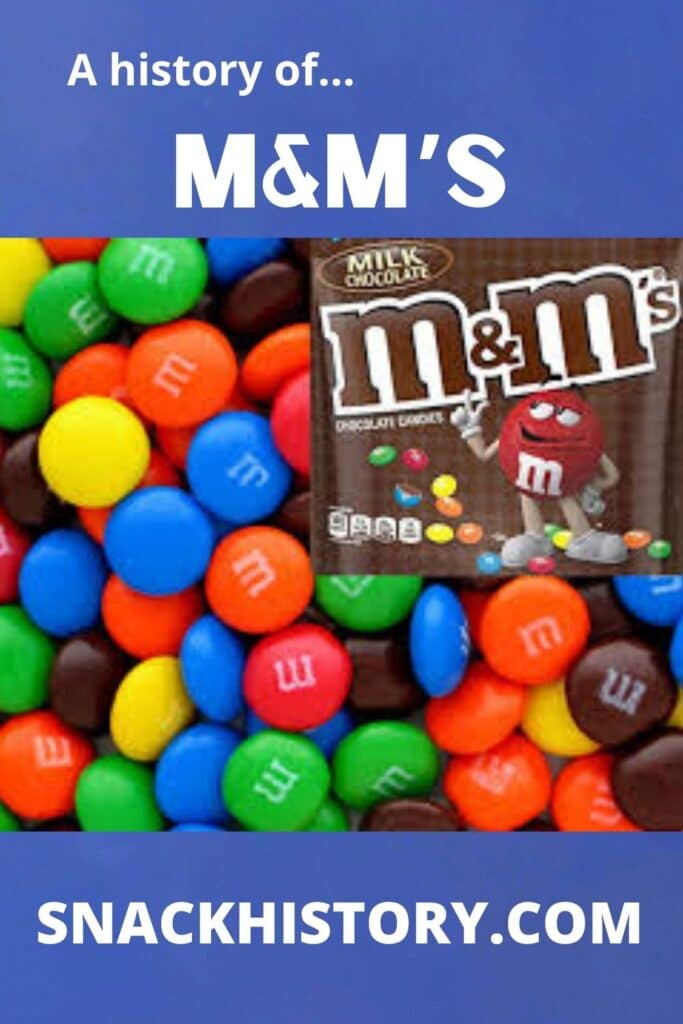
History And Information
M&M is a small piece of chocolate candy inside of a hard sugary shell that is usually colored. While once only sold in the colors of red, yellow, green, brown, orange, and violet; there have been massive extensions on both the flavor, texture, and branding of the M&M. Today, there are just under 50 different variations of the M&M style. Some interesting ones are Candy Corn White Chocolate, Jalapeno, Pumpkin Spice Latte, Crispy, Pretzel, and Mint Dark.
Please leave a review or any memories of this snack in the comments at the bottom of this page. Thank you!
The current owner of M&M candy is Mars Inc. The very first M&M was introduced on September 10th, 1941. The original colors produced in 1941 were red, yellow, green, brown, orange, and violet. An average batch of M&Ms candy comes with 30% brown, 20% each of yellow and red, and 10% each of green, orange, and blue.
The original idea for the candy shell around the soft interior chocolate actually came from a method that was used during the Spanish Civil War in the 1930s. This method of candy-making allowed for the chocolates to survive in warm climates without melting. This was later a major goal of all candy makers to allow for candy sales to be stable even during the hot parts of the year. The slogan of, “melts in your mouth, not your hand” has always been a great way for the candy company to communicate this important feature of this delightful little bite-sized candy.
The candies have always been small in size and were meant to be nibbling size rather than full confectionery sweet size. An M&M weighs in at about 0.91 grams and has about 5 calories. This is one of the smaller candy treats on the market even today and M&Ms were a novelty due to this fact as well as their unique candy shells.
Forrest Mars Sr. was the son of the Mars Company founder Frank Mars. He copied the idea of the candy shells from the confectionery items that were made in the 30s. He created his own patented process for making the hard candy shells on the little chocolate pellets which was secured in 1941. This made it possible to start production in March of 1941.
The original company was M&M Limited and the two Ms represented the names of Forrest and Bruce Murrie who was the son of Hershey’s Chocolate’s president. Hershey’s had a 20 percent share in the product which made it possible for the candies to be made with Hershey Chocolate. This was useful since Hershey controlled the rationed chocolate that was being set aside at the time for the creation of candies not sent to the soldiers overseas.
The company actually sold its first products to the U.S. Army. This was a great candy that soldiers could put in their pockets and carry with them as they were marching. This was the original exclusive contract for the company and they did not sell to the public until after the war. The tagline about melting in your mouth, not your hand was put into use in 1949 when the candies were first being sold to the public.
The black M was not printed on the candies until 1950, offering an additional layer of branding for the candies. The M was later changed to be white in 1954. This is the way that the candy is made today and you will not see candies with black Ms on them anymore.
The process of making M&Ms faster was worked on in the 50s by Midwest Research Institute in Kansas City, Missouri. The process perfected a method that allowed for 3,300 pounds of candy to be coated every hour. This allowed the company to keep up with demand and move on to crafting other kinds of varieties of the candy. Peanut M&Ms were added to the lineup in 1954 but were originally just made with a tan coating. Today they are colorful like the rest of the M&M lineup.
Orange candies were added to the mix to replace red in 1976. This was because of the red dye scare that was linked to research that indicated that red dye might cause cancer. M&Ms were never made with the dyes that were used for the studies but the public was not appeased. Red M&Ms did not return to the lineup until 1987.
M&Ms were first sold internationally in the 1980s. They were first sold in Australia, the UK, Japan, Malaysia, Hong Kong, Europe, and Canada at this time. M&Ms Royals were marketed in the 80s with a slogan that said that “now chocolate’s got a whisper of mint”. These were sold overseas with a crown in place of the M&M logo and they were pale green and brown.
Almond-centered M&Ms were brought back for a limited release in 1988 as Christmas candy and Easter candy. These are a standard at these holidays today and they are made with bunny, chick, and egg symbols on them as well as pastel-colored shells. These versions of the candies are sold overseas and in the US.
Christmas versions of the candies are also sold in all markets and they are often mint-flavored but otherwise, they appear just like regular M&Ms. Peanut Butter M&Ms arrived on the market in 1991 and have continued to be one of the most popular additional flavors that M&Ms makes.
Tan M&Ms were replaced with blue in 1995 and there was an extensive marketing campaign to roll them out that included a Home Shopping Network promotional video as well as ads with Jon Watson in them. In 1996, M&M minis were brought into the product line and were sold in tubes. This made them great stocking stuffers.
Crispy M&Ms came out in 1999 and they featured a soft wafer center. They were taken off the market in 2005 but are still sold in Europe and Southeast Asia. In 2015, they were brought back to the market in the US. Dulce de Leche M&Ms were offered in 2001 and were first rolled out in Los Angeles, San Diego, Miami, and Texas locations. In 2010, Pretzel M&Ms were offered.
There was a chocolate bar that was added to the lineup in 2013 in a partnership with Mars. This was a rebranding of a bar that had been sold briefly in 2004 under the name M-Azing. Some other short-term products were offered in the 2000s like the Shrek promotion that led to “Mega M&Ms”. M&M cookies were offered in 2016 and a contest was held to have fans decide between honey nut, coffee nut, or chili nut for the new M&M variety. Coffee Nut won the contest and was brought to market. In 2017, Caramel M&Ms were added to the lineup and a hazelnut spread was made in 2019.
How Are M&Ms Made?
You may be wondering how the M&Ms is made and what is used to make this candy. The M&M has two main components. One component is the liquid chocolate on the inside in its hardened form. The main ingredients to form this part are chocolate liquor, whole milk, cocoa butter, and sugar. The second component of an M&M candy is the outer shell made from a mix of sugar and corn syrup.
A brief quickened explanation of the manufacturing process to make an M&M is liquid chocolate is first poured into tiny molds and allowed to harden. The chocolate pellets are then put through a process called panning; which is where they are sprayed with liquid candy made of sugar and corn syrup. The final coating is the designated coloring which is added at the very last and final step.
For a brief time during the time period of the 1930’s Forrest Mars. Sr. spent time in Europe and got his big idea for the M&M candy. This idea behind why he created the M&M candy is from his time spent witnessing the need for a resistant and durable candy that withstood the temperature.
Overseas Mars witnessed soldiers during the Spanish Civil War period between 1936 to 1937 that favored chocolate encased in a hard sugary shell. The invention of the M&M was inspired by the British candy called Smarties made by the Rowntree company in 1937. As a result, he was inspired to create a candy that could be used for the average American Soldier serving in World War 2.
In 1941, Bruce and Mars finally patented the invention behind the M&M candy and the very first M&Ms were sold. The two M’s represent the names of the founders of the M&M candy. The first person is Forrest E. Mars Sr., and the other partner is Bruce Murrie, who happens to be the son of the Hershey Company’s president and one of Mars companies’ biggest competitors in the candy business.
This partnership was a combination of two of the most well-known candy makers of the time and in history. Bruce Murrie, who brought his knowledge of his famous delicacy of chocolate-making expertise, and Forrest Mars, a very ambitious businessman looking to create the best candy to measure up to his father’s business.
In the first years of production and sometime in the year 1940, M&M became an exclusive product for American soldiers and was added to American G.I rations as a “high energy” snack. During this time, M&M sold in simple brown plastic bags. Just one year later, M&Ms became available to the public. Many changes took place in the ’40s and ’50s as M&M went into its additions and branding phase of the business. In the early year of 1941, the design for M&M was patented on March 3rd, 1941 where production first began in Newark, NJ. In 1949, Murrie sold his shares of the business to the mars family.
The official “M” logo on each piece of candy was established in the year 1950. It was one of the branding mechanisms used by the company Mars to eliminate competitors’ potential imitations of the 50s candy. In 1950, the black imprinted “M” on each candy was its first unique trademark for the brand.
Soon thereafter, the addition of the production variety started with M&Ms Peanut Chocolate Candies in 1954. In that same year, the lettering of the “M” on the candy was changed from black to white. Another important business strategy that emerged was the very first slogan that developed for the M&M candies, “It Melts In Your Mouth, Not In Your Hands”, which was trademarked that same year.
Changes in color variations: In 1949, tan replaced violet. In 1954, M&M peanut chocolate candies were introduced in all brown. In 1995, blue replaced the tan color for M&M. Changes in color variations: In 1949, tan replaced violet. In 1954, M&M peanut chocolate candies were introduced in all brown. In 1995, blue replaced the tan color for M&M.
Logo
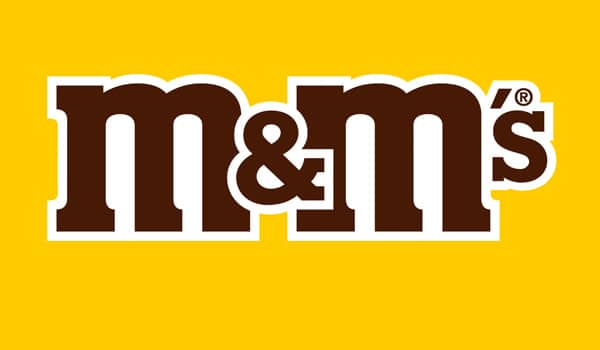
Flavors
Here is a list of the different flavors of M&Ms.
- Almond
- Birthday Cake
- Boo-terscotch
- Café Mocha
- Candy Apple
- Candy Corn White Chocolate
- Caramel
- Carrot Cake
- Cheese Cake
- Chili Nut
- Chocolate Popcorn
- Cinnamon
- Classic Mix
- Coconut
- Coconut Eggs
- Coconut Peanut
- Coffee Nut
- Cookies and Screeem
- Creepy Cocoa Crisp
- Crispy
- Crispy S’mores
- Dark Chocolate
- Double Chocolate
- Dulce De Leche
- Easter Sundae
- Eggs
- English Toffee
- Espresso
- Fudge Brownie
- Gingerbread
- Hazelnut Spread
- Holiday Mint
- Honey Nut
- Hot Chocolate
- Hot Cocoa
- Jalapeno
- Key Lime Pie
- Malt Mini Eggs
- Mega
- Milk Chocolate
- Milk Chocolate Cherry
- Mini
- Mint Crisp
- Mint Dark
- Neapolitan
- Orange Chocolate
- Orange Vanilla Cream
- Peanut Brrr-ittle
- Peanut Butter
- Peanut Dark Chocolate
- Peanut Mix
- Pecan Pie
- Pretzel
- Pumpkin Spice Latte
- Raspberry
- Razzberry
- Red Velvet
- Salted Caramel
- Strawberry
- Strawberry Nut
- Sugar Cookie
- Toffee Peanut
- Triple Chocolate
- Triple Chocolate
- Vanilla Cupcake
- White BOO-tterscotch
- White Cheesecake
- White Chocolate
- White Chocolate Candy Corn
- White Chocolate Carrot Cake
- White Chocolate Marshmallow
- White Chocolate Peppermint
- White Strawberry Shortcake
- Wildly Cherry
Ingredients
Here are the ingredients for M&Ms.
- Sugar
- Cocoa mass
- Skimmed milk powder
- Cocoa butter
- Lactose
- Starch
- Milk fat
- Palm fat
- Glucose syrup
- Shea fat
- Stabiliser (gum arabic)
- Dextrin
- Glazing agents (beeswax, carnauba wax)
- Colours (E100, carmine, E132, E133, E150a, E150c, E150d, E153, E160a, E160e, E162, E163, E170)
- Beetroot concentrate
- Emulsifiers (soya lecithin, E445)
- Salt, flavourings
- Palm kernel oil
- Antioxidant (E306)
Nutrition
| Serving Size: | 0.3 box (29g) | % Daily Value* |
| Amount Per Serving | ||
| Calories | 140 | |
| Total Fat | 6g | 9% |
| Saturated Fat | 3.5g | 18% |
| Trans Fat | 0g | |
| Cholesterol | 2.5mg | 1% |
| Sodium | 20mg | 1% |
| Total Carbohydrates | 21g | 7% |
| Dietary Fiber | 0.5g | 2% |
| Sugars | 19g | |
| Added Sugars | 18g | 36% |
| Protein | 1g | |
| Vitamin D | 0mcg | 0% |
| Calcium | 30mg | 2% |
| Iron | 0mg | 0% |
| Potassium | 0mg | 0% |
- The % Daily Value (DV) tells you how much a nutrient in a serving of food contributes to a daily diet. 2000 calories a day is used for general nutrition advice.
The Year M&Ms Was Invented
M&Ms were invented in the year 1941 and was first made in the United States.
The Company That Owns M&Ms
The company that owns M&Ms is Mars, Incorporated, an American global manufacturer of confectionery and other food products. Mars, Incorporated also makes products such as Twix, Snickers and the Milk Way bar.
Slogans
M&Ms have come up with a catchy slogan for their brand, being, “Melts in your mouth, not in your hand”. This slogan was first used in the year 1954.
Marketing
The personification of the candies as little people has been a common thread in the marketing plan for the company for years now. The cartoon-like storytelling that has linked the M&M characters with famous people and events has been a mainstay of the successful ads that the company has run over the years. This was a strategy first used in 1954 even in black and white ads. The characters were so successful that this has always been one of the mainstays of the candy advertising campaigns. Campaigns like, “All the World Loves M&Ms” as well as the “Official Candy of the New Millennium” were also very successful.
M&Ms have also made sure that they offered fan contests for flavor and color selection over the years. This has made the candy really popular with consumers and has made it possible for “Plain M&Ms” to be a fun offering for limited duration runs. There have been many contests over the years that helped determine the characters that were used for the cartoon-based ads as well and there was great excitement over the addition of a female M&M character.
Candy mascots have come and gone such as the green guy that advertised the almond variety and Orange who was a female character. There were also characters like Chocolate Bar who was not an M&M. Red M&M was also transformed into a human in a Super Bowl commercial but that was never a mainstay of the ad campaigns outside of the special limited run for the game.
Many famous actors have voiced M&Ms characters such as John Goodman, Vanessa Williams, Bill Rogers, and David Cross. The list of influential people who have been connected with the brand has continued to grow over the years as new and clever ads have been released at holidays and during special events.
The company has also offered NASCAR ad campaigns that have been a big success and there were many campaigns that were run in connection with the Shrek movies. The candies have been shown in ads in Times Square and in 2007, a Lady Liberty M&M statue was used to kick off a character creation contest to create new M&M cartoon characters for the brand.
The company has always stayed true to the original brand design for the most part and the plain brown and plain yellow wrappers for the classic flavors have remained the main marketing colors for years. The simple logo has also been used since near the beginning of the marketing of this candy. Even in international locations, the branding is largely consistent. This is not common for many candy companies and M&Ms is one of the few candy companies that has been able to market their products under the same name and livery in many different companies.
M&Ms has also dabbled in many limited-time campaigns like the Presidential M&Ms campaigns as well as the Habitat Humanity Campaign that was marketed under the slogan of, “Better with M”. There are also specialty stores in locations in Vegas, Orlando, New York, London, And Shanghai. M&Ms gear and clothing can be bought online as well as through M&Ms stores in these locations. There have even been many M&M’s themed video games made.
Pictures
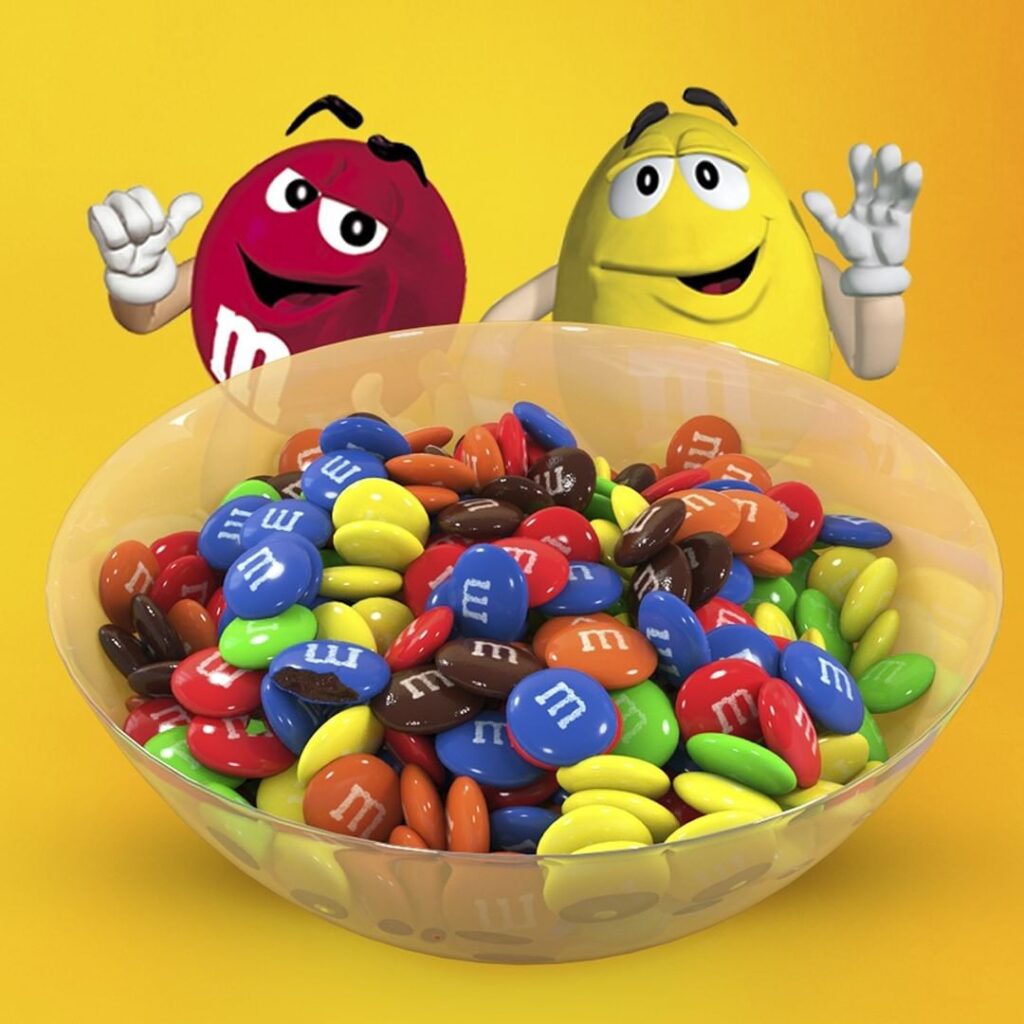
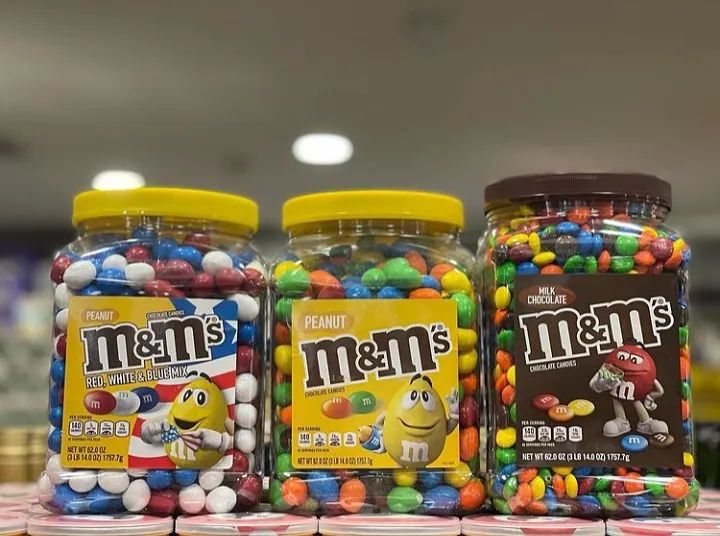
Commercials
Here is are some video advertisements for M&Ms.
FAQ
Who makes M&Ms?
The company that owns M&Ms is Mars, Incorporated, an American global manufacturer of confectionery and other food products.
How are M&Ms made?
A brief quickened explanation of the manufacturing process to make an M&M is liquid chocolate is first poured into tiny molds and allowed to harden. The chocolate pellets are then put through a process called panning; which is where they are sprayed with liquid candy made of sugar and corn syrup. The final coating is the designated coloring which is added at the very last and final step.
Who owns M&Ms?
The company that owns M&Ms is Mars, Incorporated, an American global manufacturer of confectionery and other food products.
How many M&Ms in a bag?
A typical 1.69 ounce bag of plain M&M’s contains about 56 candies.
When were M&Ms invented?
M&Ms were invented in the year 1941 and were first made in the United States.
How many peanut M&Ms in a bag?
A typical 1.69 ounce bag of plain M&M’s contains about 56 candies. Some people call the next larger bag a pi bag, because it holds 3.14 ounces of candy.
What are M&Ms made of?
Here are the ingredients for M&Ms. Sugar, Cocoa mass, Skimmed milk powder
Cocoa butter, Lactose, Starch, Milk fat, Palm fat, Glucose syrup, Shea fat, Stabiliser (gum arabic), Dextrin, Glazing agents (beeswax, carnauba wax), Colours (E100, carmine, E132, E133, E150a, E150c, E150d, E153, E160a, E160e, E162, E163, E170), Beetroot concentrate
Emulsifiers (soya lecithin, E445), Salt, flavourings, Palm kernel oil, Antioxidant (E306)
How many M&Ms in a pound?
Approximately 180 pieces per pound.
How old are M&Ms?
M&Ms were invented in the year 1941 and were first made in the United States.
How many carbs in M&Ms?
There are 10.5 carbs in Peanut M&Ms fun size bag.
How many colors of M&Ms are there?
Since 2004, M&M’s have been available online in 17 colors.

My name is Brianna and I love writing on all topics. Candy history fascinates me and I am passionate about sharing my love of this topic with everyone else!
Please leave a review or any memories of this snack in the comments below. Thank you!
Click here for a full A-Z list of Snacks and Candy
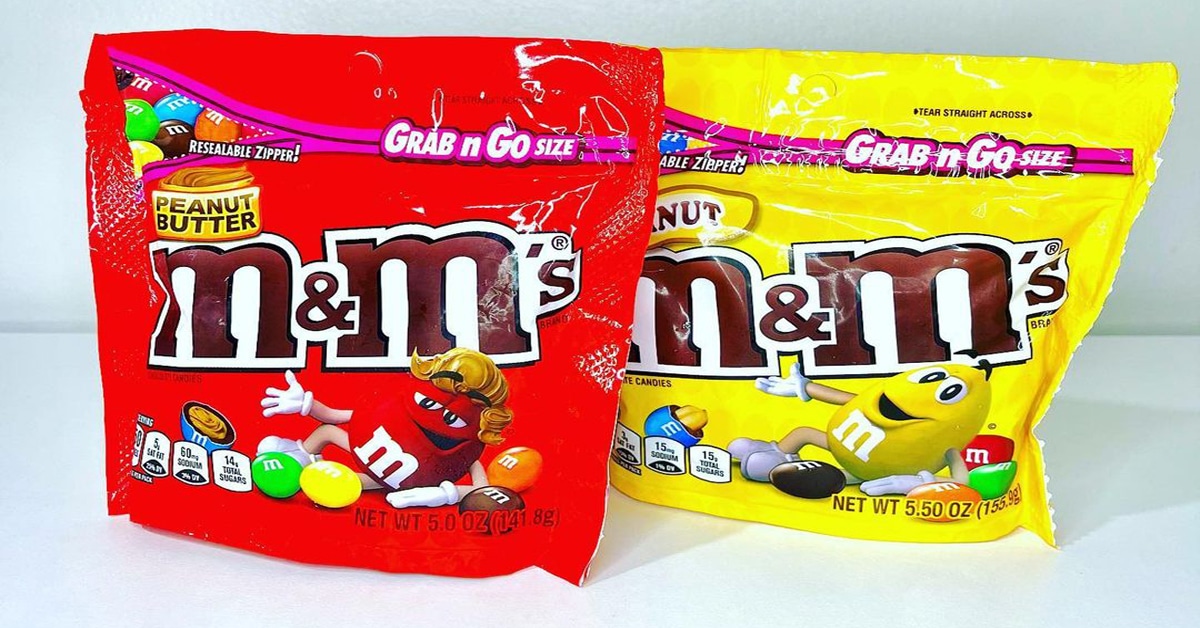
I want to know why you don’t have white M&Ms. Are you afraid to have a white M&M? If your company is becoming woke I hope you go broke.
When was peanut removed from the ingredient list of the chocolate in plain M&Ms?
The plain M&Ms do not taste good anymore!!! I am so dissappointed!!! They dont compare to the former ones. I wont be buying them anymore the new ones are disgusting !!! My M&Ms days are over!!!
Please bring coffee nut flavor back it’s my husbands favorite.
Oh my god I loved the peppermint red white and pink on Valentines day. Now I can’t find any where. What happened??
My daughter has a very severe peanut allergy. Today I went to buy a bag of caramel M&Ms that are always in the purple bag today that purple bag is peanut M&Ms in the yellow bag that used to be peanut It is now almond. When was the caramel bag changed from purple to blue? We would love to know.
Why can I not find the Harvest Blend M&Ms? Instead all you have in regular is the UGLY Halloween mix – I like to use them for Thanksgiving cookies and for nibbles when the family is here… the green and purple don’t cut it.